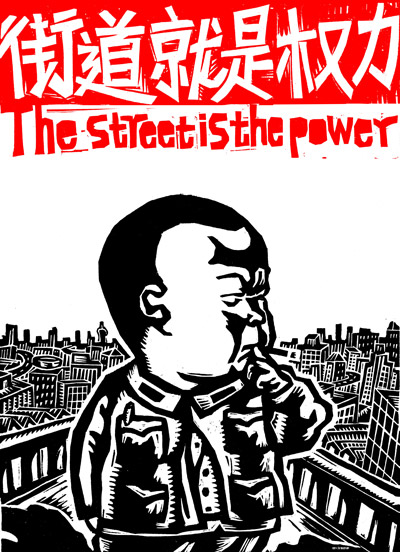IMAGES OF CIRCULATION AND RETRANSLATION
| December 1, 2010 | Post In LEAP 6

The collaboration between Contemporary Art and Investment magazine and the Iberia Center for Contemporary Art has been fruitful. In late 2009, the magazine’s staff, whose office is based in the Iberia facilities, collaborated with the center on the exhibition “Work in Progress: How Do Artists Work?” The artists shown in “Work in Progress” had all previously been selected for Contemporary Art and Investment’s “Project” column, a showcase of young Chinese artists, and the exhibition, like the column, was an attempt to lay bare the processes involved in creating a work of art.
September’s follow-up to “Work in Progress” is “Work in Spreading: Images of Circulation and Retranslation.” What exactly does this mean? If “Work in Progress” was ostensibly about revealing the machinations that go into creating a new work of art, “Work in Spreading” is about investigating how works of art circulate, and images spread. The artists in the show are selected from the pool of artists featured in the magazine’s same “Project” column, eighteen artists in total, including He An, Hu Xiangqian, Fang Lu, and Qiu Xiaofei.
But the curatorial framework for the show is feeble, and its works inconsistent. According to essays by the show’s curators, Sun Jianchun and Xu Chongbao, the central binary of the show is the difference between circulating works via text (for example, by describing works in a column such as “Projects” or a magazine such as Contemporary Art and Investment) or via exhibition. Indeed, the catalog collects interviews with each of the participating artists, asking each questions pertaining to the flow of information: for example, “Which, in your opinion, is more critical: the artwork in the exhibition hall or in the media?” or “How do you define the ‘transmission and retranslation’ of a work of art?” These questions are hardly essential to appreciating the works, more fundamental ones having been side-stepped.
The works suffered for the lack of context. The show’s contents varied wildly across the mediums, a collection of oil painting, photography, video work, installation, sculpture, and prints, each having little to do with the exhibition’s chosen theme. A wall of captioned stills by Weng Yunpeng, and prints by Liu Qingyuan stood as exceptions, each by questioning the nature of their respective mediums. And the show was not without its highlights, such as Tsui Kuang-Yu’s trio of video works, the most memorable of which features the artist walking through a UK city wearing clothing that spouts water, and whimsically perverse prints by Sun Xun.
Where “Work in Spreading” fell short as a study of the circulation of artwork and the power of media, its unevenness can also be considered its strength, a collection of unrelated but not uninteresting work. The show is probably best understood as a survey of the young and emerging artists favored by the editors of Contemporary Art and Investment and the curators of Iberia, useful framework to keep in mind next time the two groups attempt another “Work in-” exhibition. Angie Baecker

